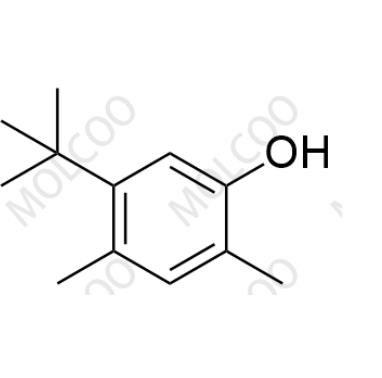Oxymetazoline Impurity 478011-12-0

Product Number: O024014
English Name: Oxymetazoline Impurity 14
English Alias: 5-(tert-butyl)-2,4-dimethylphenol
CAS Number: 478011-12-0
Molecular Formula: C₁₂H₁₈O
Molecular Weight: 178.27
Product Advantages:
Ultra-high purity:With extremely low impurity content and HPLC-verified purity ≥99.0%, it meets the rigorous requirements of reference standards for pharmaceutical quality research.
Excellent stability:Stable for 24 months when stored at 2-8°C in the dark, and with a degradation rate <1% after 7 days at room temperature in solution (e.g., methanol), ensuring reliable experimental data.
Strong batch consistency:Produced by standardized processes, it shows minimal quality variation between batches, reducing experimental errors and repeatability issues.
Applications:
Pharmaceutical quality control:Serves as an impurity reference standard for oxymetazoline APIs and formulations, used for quantitative analysis of impurities by HPLC or GC to ensure compliance with ICH Q3A standards (e.g., ≤0.1%).
Analytical method validation:Acts as a reference material in pharmaceutical analysis laboratories to calibrate instruments (e.g., liquid chromatographs) and verify the accuracy of analytical methods, ensuring the reliability of test results.
Process optimization research:By monitoring the formation of this impurity during synthesis (e.g., reducing impurity content from 0.5% to 0.1% when reaction temperature decreases from 80°C to 60°C), the oxymetazoline preparation process can be optimized to reduce by-product generation.
Background Description:
Oxymetazoline Impurity 14 is an impurity introduced during oxymetazoline synthesis due to incomplete alkylation of phenolic intermediates or excessive reagent use. This impurity may affect drug stability and safety. With the increasing requirements for impurity control by global regulatory agencies (such as FDA and EMA), accurate detection and control of this impurity have become critical in drug research and production. It is currently listed as a specific impurity in major pharmacopoeias, requiring qualitative identification and quantitative control.
Research Status:
Development of detection techniques:The mainstream detection method is HPLC-UV, using a C18 column (5μm, 4.6×250mm), mobile phase acetonitrile-water (60:40, v/v), detection wavelength 275nm, and a limit of quantitation (LOQ) of 0.02%. LC-MS/MS technology can further reduce the detection limit to 0.1ppm, suitable for trace impurity screening.
Synthesis process optimization:Studies have shown that impurity formation is positively correlated with the dosage of alkylating agents (such as tert-butyl chloride) and reaction time. Adding reagents at low temperature (≤50°C) and controlling the molar ratio (raw material: reagent = 1:1.1) can reduce impurity formation by over 80%.
Toxicological research:Animal experiments indicate that this impurity may cause slight elevation of liver enzymes at high doses (≥200mg/kg), but the toxicological risk is extremely low under normal dosing. For safety considerations, pharmaceutical standards typically set its limit at ≤0.15%.
